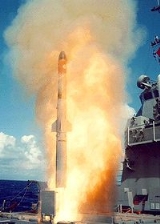
RUM-139 VL-Asroc
Encyclopedia
The RUM-139 VL-ASROC is an anti-submarine missile in the ASROC
family, currently built by the Lockheed Martin
company for the U.S. Navy.
The design and development of the missile began in 1983 when the Goodyear Aerospace
company was contracted by the U.S. Navy to develop a ship-launched anti-submarine missile compatible with the new Mark 41 Vertical Launch System
. The development of the VLS ASROC underwent many delays, and it was not deployed on any ships until 1993. During this development, Goodyear Aerospace was bought by the Loral aerospace company in 1986, and this defense division was in turn purchased by Lockheed Martin Aerospace in 1995.
The first VLS ASROC missile was an RUR-5 ASROC with an upgraded solid-fuel booster section and a digital guidance system. It carries a lightweight Mark 46 torpedo
homing torpedo that is dropped from the rocket at a precalculated point on its trajectory, and then parachuted into the sea. Beginning in 1996, the missile was replaced by the newer RUM-139A and subsequently the RUM-139B. The torpedo has remained the Mk-46, though at one time an improved torpedo called the Mark-51 was proposed, and then cancelled. The RUM-139C is now in production since October 2004 with the Mark 54 torpedo.
The vertical-launched missile first became operational in 1993, with more than 450 having been produced by 2007. It is 4.5 metres (14.8 ft) in length, with a firing range of about 11.8 nm or 22 kilometres (24,059.5 yd).
ASROC
ASROC is an all-weather, all sea-conditions anti-submarine missile system. Developed by the United States Navy in the 1950s, it was deployed in the 1960s, updated in the 1990s, and eventually installed on over 200 USN surface ships, specifically cruisers, destroyers, and frigates...
family, currently built by the Lockheed Martin
Lockheed Martin
Lockheed Martin is an American global aerospace, defense, security, and advanced technology company with worldwide interests. It was formed by the merger of Lockheed Corporation with Martin Marietta in March 1995. It is headquartered in Bethesda, Maryland, in the Washington Metropolitan Area....
company for the U.S. Navy.
The design and development of the missile began in 1983 when the Goodyear Aerospace
Goodyear Aerospace
Goodyear Aerospace Corporation was the aerospace and defense subsidiary of Goodyear.-Early Years:The company began as Goodyear Tire & Rubber Co.’s Aeronautics Department and renamed in 1917 as the Goodyear Zeppelin Corporation set up to construct dirigibles for the US military...
company was contracted by the U.S. Navy to develop a ship-launched anti-submarine missile compatible with the new Mark 41 Vertical Launch System
Mark 41 Vertical Launch System
The Mark 41 Vertical Launch System is a shipborne missle canister launching system which provides a rapid-fire launch capability against hostile threats. The Vertical Launch System concept was derived from work on the Aegis Combat System. Refinement of the concept continued through the 1960s and...
. The development of the VLS ASROC underwent many delays, and it was not deployed on any ships until 1993. During this development, Goodyear Aerospace was bought by the Loral aerospace company in 1986, and this defense division was in turn purchased by Lockheed Martin Aerospace in 1995.
The first VLS ASROC missile was an RUR-5 ASROC with an upgraded solid-fuel booster section and a digital guidance system. It carries a lightweight Mark 46 torpedo
Mark 46 torpedo
Designed to attack high-performance submarines, the Mark 46 torpedo is the backbone of the U.S. Navy's lightweight ASW torpedo inventory, and is the current NATO standard. These aerial torpedoes, such as the Mark 46 Mod 5, are expected to remain in service until the year 2015...
homing torpedo that is dropped from the rocket at a precalculated point on its trajectory, and then parachuted into the sea. Beginning in 1996, the missile was replaced by the newer RUM-139A and subsequently the RUM-139B. The torpedo has remained the Mk-46, though at one time an improved torpedo called the Mark-51 was proposed, and then cancelled. The RUM-139C is now in production since October 2004 with the Mark 54 torpedo.
The vertical-launched missile first became operational in 1993, with more than 450 having been produced by 2007. It is 4.5 metres (14.8 ft) in length, with a firing range of about 11.8 nm or 22 kilometres (24,059.5 yd).

